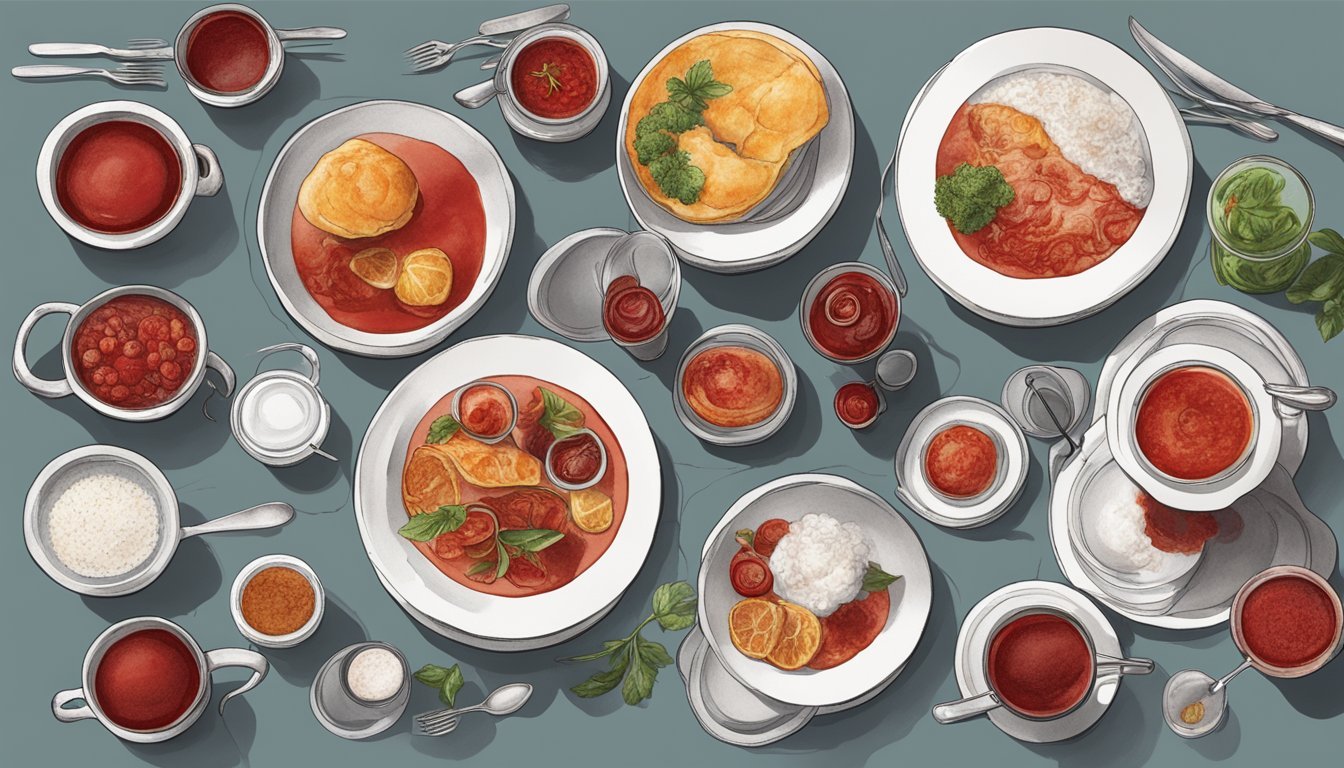10 Delicacies Made with Blood
Exploring Unique Culinary Traditions
Blood has been used as a culinary ingredient across various cultures for centuries, contributing to unique and robust flavors in traditional dishes. These blood-based delicacies often hold significant cultural, historical, and nutritional value, reflecting the diverse ways different societies utilize every part of an animal.
Exploring these blood-infused foods reveals not only the culinary creativity of different regions but also their deep-rooted traditions and practices. From rich sausages to sweet confections, the use of blood in cooking spans continents and cuisines, offering a peek into the world's culinary diversity and ingenuity.
1) Blood Sausage
Blood sausage is a culinary delicacy known for its rich, distinctive flavor. It is made primarily from animal blood, often combined with fillers like rice, barley, oatmeal, or breadcrumbs. These ingredients are encased in sausage skins, typically made from the intestines of the same animal whose blood is used.
The preparation of blood sausage varies across cultures. In some regions, it includes additional ingredients like onions, fat, and various spices. For instance, British black pudding is a well-known type of blood sausage that incorporates oatmeal and fat.
Blood sausage is a traditional food in many parts of the world. In Kenya, mutura is a popular variation, often filled with minced meat, onions, and spices. This regional dish highlights the versatility and cultural significance of blood-based foods.
When it comes to taste, blood sausage has a unique, earthy flavor with a slight metallic undertone, often described as coppery. This distinctive taste might not be for everyone, but it is cherished by many for its robust and hearty flavor profile.
2) Sanguinaccio Dolce
Sanguinaccio Dolce is a unique Italian dessert that incorporates pig's blood into its ingredients. Originating from southern Italy, this pudding-like delicacy combines blood with chocolate to create a rich and creamy treat.
The dish's base consists of cocoa powder, sugar, and flour, which are mixed and heated with milk. Pig's blood is then added to thicken the mixture and give it its distinctive texture. This process results in a luxurious, velvety dessert.
Sanguinaccio Dolce has gained some cultural notoriety, even being featured in popular media like the TV series Hannibal. While it might seem unconventional, this dessert is celebrated for its intense chocolate flavor, enhanced by the unique addition of blood.
For those interested in trying Sanguinaccio Dolce, it can sometimes be found in specialized Italian eateries, particularly in regions with a strong Italian culinary presence. It’s a rare find but a worthwhile indulgence for adventurous food enthusiasts.
3) Dinh Gout Blood Soup
Dinh Gout Blood Soup is a traditional Vietnamese delicacy often prepared for large family gatherings.
It's commonly made from freshly butchered ducks, utilizing every part of the animal, including the blood. The blood is typically clotted and made into small cakes that are later added to the soup.
Ingredients include duck meat, duck blood cakes, and various Vietnamese herbs. The combination of these elements results in a rich and flavorful soup that is both nutritious and deeply rooted in cultural tradition.
This soup is not only a culinary experience but also a significant part of Vietnamese heritage. People often prepare it during festive occasions to celebrate togetherness and family bonds.
4) Kroppkaka
Kroppkaka is a traditional Swedish dish consisting of potato dumplings. These dumplings are typically filled with a savory mix of pork, often bacon, and onions. Originating from the Baltic island of Öland, this dish has roots going back to the 1700s when potatoes became a staple in Swedish cuisine.
Preparation involves boiling the potatoes until they are soft, then mashing and mixing them with flour and eggs to form a dough. Small portions of this dough are filled with the pork mixture, shaped into balls, and boiled in salted water.
Kroppkakor is not just a culinary delight but also a reflection of Swedish tradition. The use of spices like allspice or white pepper adds a unique flavor. These dumplings are often served with lingonberry sauce, enhancing the dish's taste with a touch of sweetness.
The dish's popularity in Sweden is akin to similar dumplings found in Norway and Lithuania, known as raspeballs and cepelinai, respectively.
5) Black Pudding
Black pudding is a type of blood sausage traditionally enjoyed in the United Kingdom and Ireland. It is celebrated for its rich, savory flavor and distinctive dark color, which comes from the inclusion of pig's blood. The mixture typically includes oats or barley, which help to bind the ingredients together.
This dish has deep historical roots, dating back to medieval times. It is believed that black pudding was enjoyed as far back as the 15th century. Cooks originally created it as a way to use every part of the animal, ensuring nothing went to waste.
Black pudding is often served as part of a full English or Irish breakfast. It is usually fried or grilled and paired with eggs, tomatoes, and other traditional breakfast items. The texture is soft yet crumbly, providing a unique contrast to other breakfast foods.
In addition to its role in breakfast, black pudding can also be found in soups, stews, and as an ingredient in various dishes. Its versatility makes it a favorite among chefs and home cooks alike.
With its rich flavor and historical significance, black pudding continues to be a beloved staple in British and Irish cuisine. Whether enjoyed at breakfast or as part of a hearty meal, it remains a testament to the culinary creativity of the past.
6) Drákongrafía
Drákongrafía is a traditional dish from Greece, known for its unique use of animal blood. It is a savory pie, often made with a mix of spices, herbs, and rice bound by the rich, flavorful blood of a sheep or goat.
The preparation begins with carefully collecting the fresh blood to ensure it remains unclotted. This blood is then seasoned with a blend of spices and mixed with rice, onions, and sometimes other organ meats.
The mixture is encased in a flaky pastry dough and baked until the crust is golden and the filling is cooked through. The result is a filling and deeply savory delicacy that showcases the resourcefulness of traditional Greek cuisine.
Drákongrafía is typically served during special occasions and festive events, reflecting its cultural significance. It offers a distinct flavor profile that combines savory and slightly tangy notes, making it a memorable dish for those who try it.
7) Blodpalt
Blodpalt is a traditional dish from the northern parts of Sweden and Finnish Lapland. These dumplings are made using rye or barley flour mixed with animal blood, giving them their distinctive dark-brown color. Historically, reindeer's blood was commonly used, although various regional variations now employ blood from different animals.
Blodpalt's origin lies in a time when households carefully utilized every part of an animal to ensure that nothing was wasted. This practice of sustainability has helped blodpalt remain relatively common in these regions.
The Sami people also contribute to the tradition of blodpalt, adding their unique touches to the dish. They occasionally serve it with reindeer bone marrow, further enriching its flavor.
To prepare blodpalt, cold blood is combined with flour and a pinch of salt until the mixture is smooth and thick. The dumplings are then dropped into boiling broth, where they initially sink but eventually rise to the surface when cooked.
Blodpalt is praised for its nutritional value. It serves as an excellent source of iron and protein, aligning with the Sami people's belief in the health benefits of consuming blood-based dishes.
8) Blood Stew
Blood stew is a well-known delicacy in various cultures. One prominent example is Dinuguan, a Filipino pork blood stew.
This dish involves simmering pig's blood with vinegar, pork belly, garlic, and onions until it forms a thick and savory sauce.
The rich flavor and smooth texture of blood stew make it a unique culinary experience. The addition of bay leaves and chiles creates a robust and spicy dish.
Blood stew can be paired with steamed rice or enjoyed on its own. Its deep roots in tradition reflect the resourcefulness of using every part of the animal.
Another popular form is Czernina, a Polish duck blood stew. This version combines duck blood with vinegar, sugar, dried fruits, and spices to create a sweet and tangy flavor profile.
The dish has historical significance in Poland, where it has been enjoyed for centuries. Often served with noodles or potatoes, Czernina offers a hearty meal that showcases the ingenuity of traditional cooking methods.
Blood stew in all its forms demonstrates the versatility and richness of blood as a cooking ingredient, cherished by many cultures for its unique taste and nutritional benefits.
9) Blood Pancakes
Blood pancakes are an unusual yet traditional dish found in various cultures, especially in Scandinavia. These pancakes use animal blood, typically from pigs, as a primary ingredient. The blood acts as a substitute for eggs, providing protein and binding the flour and milk together.
The resulting batter turns a dark color when cooked. The dish has a dense and savory texture, unlike the light and fluffy nature of regular pancakes. In Scandinavian recipes, ingredients like onions, spices, bread crumbs, and molasses are often added to enhance flavor.
Blood pancakes are typically served with lingonberry jam or fried pork. The combination of savory and sweet is a distinct characteristic of this dish. The use of blood in pancakes reflects a resourceful culinary tradition where no part of the animal goes to waste.
Cooking blood pancakes involves common pancake techniques. The batter is poured into a hot pan and cooked until set on one side before flipping. The process resembles making any other type of pancake, though the unique ingredients bring a distinct and rich flavor.
10) Tiết Canh
Tiết Canh is a traditional Vietnamese delicacy known for its unique preparation and bold flavors. It features raw animal blood, typically from pigs or ducks, mixed with fish sauce and cooked meat.
The dish is particularly popular in Northern Vietnam. It is often garnished with herbs such as Vietnamese coriander and mint.
Preparing Tiết Canh involves allowing the blood to coagulate, creating a jelly-like texture. This allows the meat and blood mixture to bind together. The use of fish sauce adds a salty depth to the flavor profile.
Some variations use pork, duck, or even goose blood. The meat used can be fried or roasted, adding a contrasting texture and flavor. Peanuts are often sprinkled on top for added crunch and taste.
Tiết Canh is served cold, usually as an appetizer or a side dish. Its vibrant red color and unique texture make it a visually striking dish. The combination of fresh herbs, savory meat, and the unique texture of coagulated blood create a memorable culinary experience.
Although it may not suit every palate, Tiết Canh offers a glimpse into traditional Vietnamese cuisine. It illustrates the resourceful and adventurous use of ingredients in Vietnamese cooking. The dish reflects a cultural appreciation for flavors and textures that may seem unconventional to outsiders.
Historical Context of Blood-Based Dishes
Blood-based dishes hold significant cultural importance and exhibit regional diversity. Different societies have integrated animal blood into their culinary traditions in unique ways, reflecting their cultural practices and regional tastes.
Cultural Significance
Blood has been used as a culinary ingredient for centuries. In many cultures, it is believed to have nutritional and medicinal properties. For example, in ancient Europe, blood sausages were power foods for warriors.
During rites of passage and seasonal festivals, blood-based dishes were often central. They symbolized life and death, linking people to their ancestral practices. Blood consumption also signified resourcefulness and respect for the sacrificed animal.
In Asia, blood's cultural role in dishes like pig’s blood cake reflects its symbolic association with strength and vitality. The use of blood is often intertwined with local traditions and customs, underscoring its significance.
Regional Variations
Blood dishes vary widely across different regions. In Europe, black pudding, a mix of animal blood, fat, and oats, is a staple in British and Irish breakfasts. Portugal has a similar dish called "Morcela."
In Asia, dishes like blood tofu in China and pig’s blood cakes in Taiwan are prevalent. In Africa, Maasai tribes drink cow blood mixed with milk as a traditional sustenance.
In Latin America, morcilla, a type of blood sausage, is enjoyed in countries like Argentina and Uruguay. These regional dishes not only reflect dietary practices but also showcase the innovative ways societies have utilized available resources.
Nutritional Value and Health Implications
Blood-based dishes offer significant nutritional benefits due to their high levels of protein and iron, but there are also potential risks associated with their consumption.
Protein and Iron Content
Blood is a rich source of protein and iron, essential nutrients for the body. The high protein content helps in muscle building and repair.
Iron found in blood is vital for producing hemoglobin, which carries oxygen in the blood. This is especially beneficial for individuals with iron deficiencies.
For example, dishes such as blood sausage and blood pudding contain abundant iron and can contribute to improved hemoglobin levels. Iron-rich dishes are also beneficial for those suffering from anemia.
Potential Risks
While blood dishes offer nutritional benefits, potential risks need consideration. Improper handling and cooking can lead to bacterial contamination like salmonella or E. coli.
Certain cultural and religious dietary restrictions may prohibit the consumption of blood dishes due to traditional beliefs.
Consuming blood dishes can sometimes pose risks for those with high cholesterol or cardiovascular conditions, as some blood-based foods can be high in saturated fats.
Awareness of these risks is essential for informed dietary choices.
Ethical Considerations and Sustainability
Ethical and sustainability issues surrounding blood-based delicacies involve both animal welfare and environmental impact. These concerns are crucial due to the implications of sourcing and producing such ingredients.
Animal Welfare Concerns
Blood-based dishes often involve animal blood as a primary ingredient. Ensuring humane treatment during the slaughtering process is vital. Regulations and certifications enforce standards that mandate humane practices, but adherence varies globally.
Organizations like the World Animal Protection advocate for higher welfare standards in the food industry, emphasizing humane slaughter practices to minimize animal suffering. Ethical consumers are increasingly demanding transparency in sourcing, leading to a push for certifications that verify humane treatment.
Environmental Impact
The production of blood-based foods can also have significant environmental repercussions. The meat industry, in general, contributes to greenhouse gas emissions, deforestation, and water consumption. Utilizing animal blood, a byproduct, could reduce waste, but the overall environmental footprint remains concerning.
Sustainable practices in sourcing and processing blood are essential. Implementing eco-friendly techniques and reducing waste can mitigate some environmental impacts. Producers are encouraged to adopt sustainable farming practices to lessen their ecological footprint.








